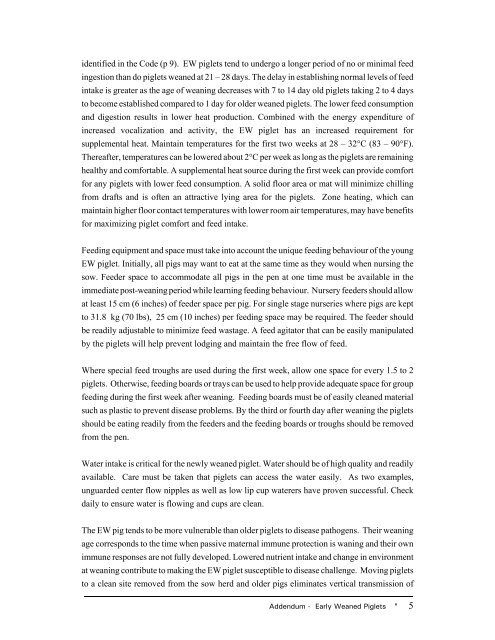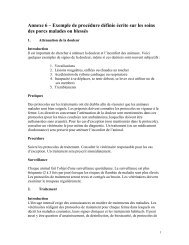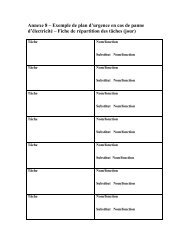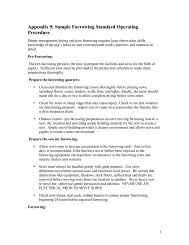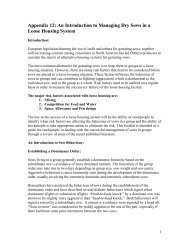Early Weaned Pigs - Carc-Crac.ca
Early Weaned Pigs - Carc-Crac.ca
Early Weaned Pigs - Carc-Crac.ca
You also want an ePaper? Increase the reach of your titles
YUMPU automatically turns print PDFs into web optimized ePapers that Google loves.
identified in the Code (p 9). EW piglets tend to undergo a longer period of no or minimal feed<br />
ingestion than do piglets weaned at 21 – 28 days. The delay in establishing normal levels of feed<br />
intake is greater as the age of weaning decreases with 7 to 14 day old piglets taking 2 to 4 days<br />
to become established compared to 1 day for older weaned piglets. The lower feed consumption<br />
and digestion results in lower heat production. Combined with the energy expenditure of<br />
increased vo<strong>ca</strong>lization and activity, the EW piglet has an increased requirement for<br />
supplemental heat. Maintain temperatures for the first two weeks at 28 – 32°C (83 – 90°F).<br />
Thereafter, temperatures <strong>ca</strong>n be lowered about 2°C per week as long as the piglets are remaining<br />
healthy and comfortable. A supplemental heat source during the first week <strong>ca</strong>n provide comfort<br />
for any piglets with lower feed consumption. A solid floor area or mat will minimize chilling<br />
from drafts and is often an attractive lying area for the piglets. Zone heating, which <strong>ca</strong>n<br />
maintain higher floor contact temperatures with lower room air temperatures, may have benefits<br />
for maximizing piglet comfort and feed intake.<br />
Feeding equipment and space must take into account the unique feeding behaviour of the young<br />
EW piglet. Initially, all pigs may want to eat at the same time as they would when nursing the<br />
sow. Feeder space to accommodate all pigs in the pen at one time must be available in the<br />
immediate post-weaning period while learning feeding behaviour. Nursery feeders should allow<br />
at least 15 cm (6 inches) of feeder space per pig. For single stage nurseries where pigs are kept<br />
to 31.8 kg (70 lbs), 25 cm (10 inches) per feeding space may be required. The feeder should<br />
be readily adjustable to minimize feed wastage. A feed agitator that <strong>ca</strong>n be easily manipulated<br />
by the piglets will help prevent lodging and maintain the free flow of feed.<br />
Where special feed troughs are used during the first week, allow one space for every 1.5 to 2<br />
piglets. Otherwise, feeding boards or trays <strong>ca</strong>n be used to help provide adequate space for group<br />
feeding during the first week after weaning. Feeding boards must be of easily cleaned material<br />
such as plastic to prevent disease problems. By the third or fourth day after weaning the piglets<br />
should be eating readily from the feeders and the feeding boards or troughs should be removed<br />
from the pen.<br />
Water intake is criti<strong>ca</strong>l for the newly weaned piglet. Water should be of high quality and readily<br />
available. Care must be taken that piglets <strong>ca</strong>n access the water easily. As two examples,<br />
unguarded center flow nipples as well as low lip cup waterers have proven successful. Check<br />
daily to ensure water is flowing and cups are clean.<br />
The EW pig tends to be more vulnerable than older piglets to disease pathogens. Their weaning<br />
age corresponds to the time when passive maternal immune protection is waning and their own<br />
immune responses are not fully developed. Lowered nutrient intake and change in environment<br />
at weaning contribute to making the EW piglet susceptible to disease challenge. Moving piglets<br />
to a clean site removed from the sow herd and older pigs eliminates verti<strong>ca</strong>l transmission of<br />
Addendum - <strong>Early</strong> <strong>Weaned</strong> Piglets " 5


